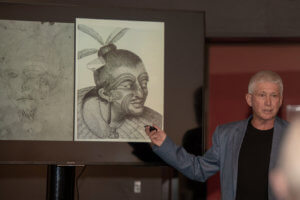
LONG WAY FROM HOME: Recently returned from the Oceania, and Pacific Encounters, exhibitions in London, Toihoukura Māori Visual Art and Design school associate professor Steve Gibbs talked about the need for taonga to be repatriated. Picture by Phil Yeo
The story of British explorer James Cook’s arrival wasn’t a nice one for Māori, said Toihoukura Māori Visual Art and Design school associate professor Steve Gibbs at a talk on Saturday night.
Held at Tairāwhiti Museum, Oceania and Pacific Encounters — A Local Perspective looked at the connection between Tairāwhiti and taonga held in the Oceania exhibition at London’s Royal Academy, and the Pacific Encounters exhibition at National Maritime Museum.
Joined by Pacific anthropologist Dame Anne Salmond, Mr Gibbs talked about how the taonga such as hoe (waka paddles) and woven cloak came to be there, his experience of encountering them, and what contemporary artists might learn about the artworks.
“We have accounts that say those paddles were taken, they were traded, but most important is that they’re there,” he said.
Designs painted on hoe preserved in a British museum were the same Mr Gibbs had seen in the kōwhaiwhai patterns in a Rongowhakaata meeting house.
“They belong to the Tūranga people,” said Mr Gibbs.
“The feeling was that we need to take them home. They speak very loudly that they’re from here. They said to me ‘get me out of here’. They don’t belong in drawers — this is the case with thousands of taonga, not just from here.”
Shortly after the fatal shootings in October 1769, six waka approached the Endeavour which was becalmed off Whareongonga. Another waka appeared from “around the corner”, paddled by the man believed to have shared a hongi with Cook on October 9. The man brought with him three hoe that were traded with crew or gifted to Tahitian navigator Tupaia and taken to England.
“There’s a lot of discussion about what happened,” said Mr Gibbs. “This was the first peaceful encounter after the first tumultuous couple of days.”
A drawing believed to have been made by Endeavour’s botanical illustrator and natural history artist Sydney Parkinson during the exchange was later made into an engraving. The image (pictured) is believed to be of the same man Cook shared a hongi with on the rock Te Toka a Taiau in the Tūranganui River on October 9, 1769.
Blue glass bead and nails were exchanged for the three hoe and a cloak naturalist Joseph Banks wears in Benjamin West’s 1773 painting. The hoe are preserved in the British Museum.
As part of his PhD study Mr Gibbs went overseas in search of the hoe to include in a taonga database.
(article courtesy of Gisborne Herald)
